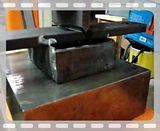scarlo101
Silver Member
Hi everyone.
I have recently purchased a used 45 ton ironworker. I want to construct my own brake dies. Does anybody have any experience building a brake V-block and blade or where I can find such info. I am currently building a FEL for my BX1850 as well as many future attachments and this ironworker will be a great tool.
Thanks in advance.
I have recently purchased a used 45 ton ironworker. I want to construct my own brake dies. Does anybody have any experience building a brake V-block and blade or where I can find such info. I am currently building a FEL for my BX1850 as well as many future attachments and this ironworker will be a great tool.
Thanks in advance.

